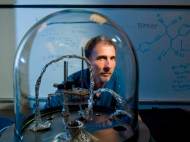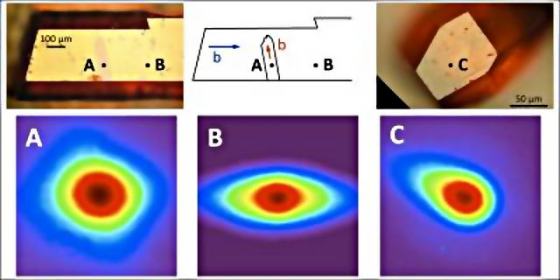Researchers use advanced imaging to observe excitons at room temperature
 Excitons, which are created by light, play a central role in the plastic solar cells energy harvesting. Researchers from Lehigh University have developed an imaging technique that enables direct observation of light-emitting excitons as they diffuse in rubrene – a new generation of single-crystal organic semiconductors that is being explored for its extraordinary electronic properties.
Excitons, which are created by light, play a central role in the plastic solar cells energy harvesting. Researchers from Lehigh University have developed an imaging technique that enables direct observation of light-emitting excitons as they diffuse in rubrene – a new generation of single-crystal organic semiconductors that is being explored for its extraordinary electronic properties.
The research was performed by Ivan Biaggio, professor of physics at Lehigh University, and Pavel Irkhin, a Ph.D. candidate, and it represents the first time that an advanced imaging technique has been used to witness the long-range diffusion of energy-carrying excitons in an organic crystal.
Biaggio’s group used a focused laser beam to create excitons in a crystal made of organic molecules. They tracked the movements of the excitons over distances smaller than the size of a human hair by directly taking pictures of the light that they emit.
After excitons are created in plastic solar cells, they diffuse toward specially designed interfaces where they drive electrons into an external circuit, creating the flow of electrons we know as electric current. This diffusion process is one of the technical challenges limiting the efficiency of plastic solar cells.
“This is the first time that excitons have been directly viewed in a molecular material at room temperature”, said Biaggio. “We believe the technique we have demonstrated will be exploited by other researchers to develop a better understanding of exciton diffusion and the bottleneck it forms in plastic solar cells.”
Thanks to the direct imaging of the diffusing excitons, the researchers were able to obtain precise measurement of their diffusion length. The results led to a conclusion that the length is very large in a particular direction, reaching a value several hundreds of times larger than in the plastic solar cells that are currently used.
“It is important that physicists explore the most fundamental phenomena underlying the mechanisms that enable solar energy harvesting with cheap organic materials”, said Biaggio. “Organics have lots of unexplored potential and the very efficient exciton diffusion that we have observed in rubrene may build the basis for new ideas and technologies towards the development of ever more efficient and plastic solar cells.”
For more information, read the article published in the journal Physical Review Letters named: “Direct Imaging of Anisotropic Exciton Diffusion and Triplet Diffusion Length in Rubrene Single Crystals”.










Leave your response!